You’re showing on the rail, and the moment your horse hears the click of the announcer’s microphone, he surges into a lope. Or, in your horsemanship pattern, he anticipates the lead change and switches early, tossing his head for good measure. Or, in your showmanship class, he fidgets at the end of the lead line and tries to snatch at it with his mouth, infractions he’d never try at home. Whatever his antics, he knows he’s going to get away with them—because he’s at a show.
[RELATED: ALL-AROUND HORSE SHOW PREP]
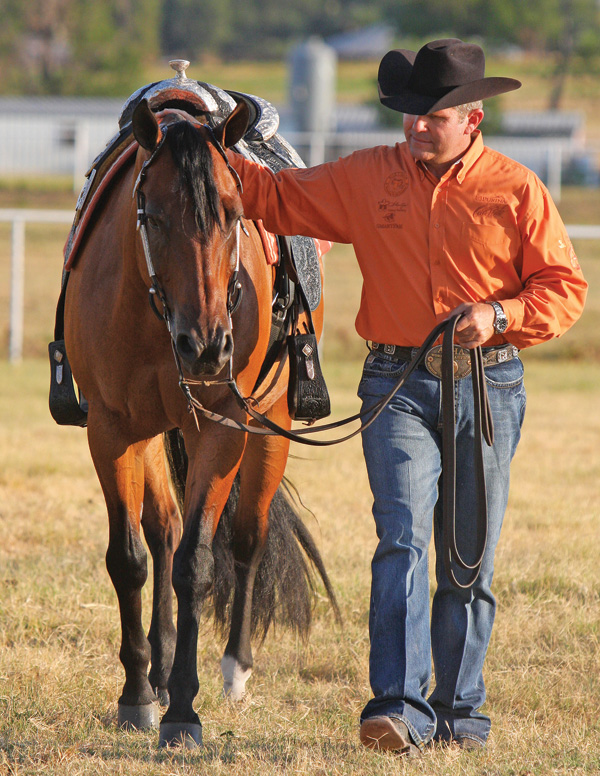
If your seasoned campaigner is pulling these sorts of shenanigans, I can help. I’ll explain why these behaviors are so common among veteran show horses, plus give you strategies for overcoming them. I’ll also provide tips on how to prevent this behavior from getting started in the first place, plus how to extend the overall longevity of your show horse.
My model in the accompanying photos, appropriately, is multi-world champion Quarter Horse gelding Harley D Zip. He’s been competing in the show pen for more than 14 years, so it wouldn’t be surprising if he’d had the notion to cheat from time to time. But because I employ the tactics I’ll describe to you now, he’s remained honest even after such a long career.
If he can do it, your horse can, too.
His Cheatin’ Heart—Why?
The foundation for a horse’s learning to cheat is his realization that you ride him differently at a show than you do at home. At home, you’re schooling him, and so will correct him when he errs. At a show, you’re trying to win a class, so rather than drawing attention to an error or misbehavior by correcting it, you’ll ride through it and try to cover it up instead.
Over time, your horse figures this out. He notices that you never get after him in competition, so he begins to think, Hot diggity! At a show, I can do what I want! He actually sees it as an open invitation to cheat. He’s like a child who goes to grandma’s house and does whatever he pleases—knowing grandma will let him get away with it.
Add to this equation the fact that horses have terrific memories, and readily learn patterns and sequences. Eventually, your horse knows exactly what to expect from each of his classes. At this point, boredom can prompt him to “get creative” by anticipating each transition and change of direction and “volunteering” to do it early.
[RELATED: KEEP HIM FOCUSED]
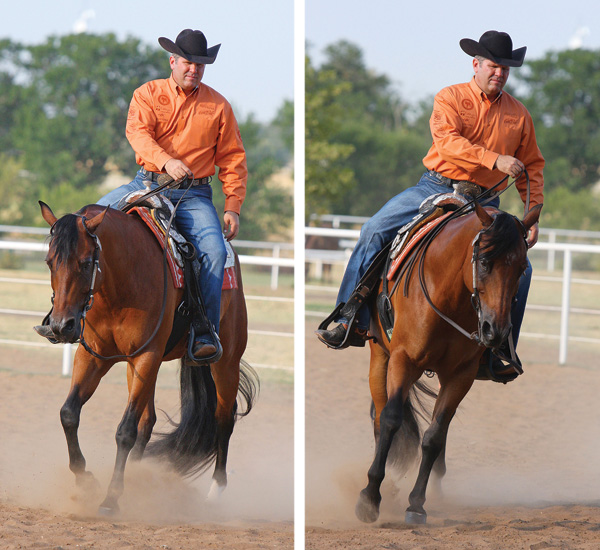
If you compound the problem by always schooling the same way at home (walk-jog-lope-reverse, for example, or riding your pattern in the same sequence every time), you’ll intensify this effect.
Horses that are shown a lot also learn to take cues from the announcer. They learn the routine commands, and even get to the point where the click of the microphone sets them off.
Clearly, this can become a seriously exasperating problem.
Take Back Control
But it doesn’t have to. Here are some strategies to use at home to “recalibrate” your horse’s expectations and begin to correct his cheating behavior. Then I’ll explain how to genuinely rock his world by schooling him the same way—at a show.
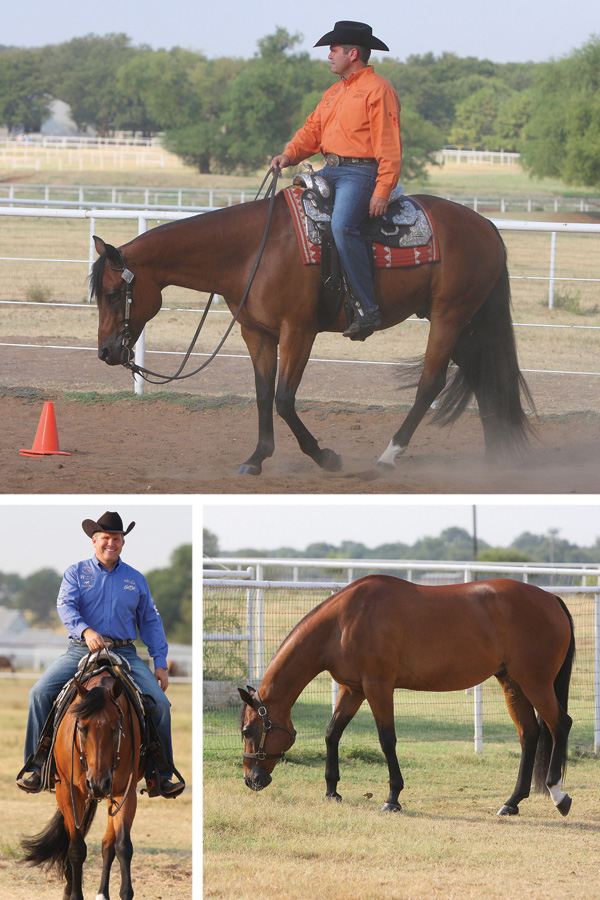
At-Home Fixes. The key with these strategies is to be 100-percent consistent in using them. If you are, your horse will begin to realize that you’re always the one in charge of what he does at any given moment. If, however, you correct him one day and let him get away with one of these “cheats” the next, you’ll just reinforce the thought in his mind that sometimes he can cheat.
[RELATED: PLAN YOUR RIDE]
Here are the cheating behaviors, and my fixes.
Anticipating the ‘go-forward’ cue: Let’s say you’ve worked your horse at a walk and jog and have brought him back to a walk during a schooling session. Now you can feel him getting antsy as he anticipates loping. Instead of asking for the lope, keep him at a walk all the way around the arena. Then jog again, then walk, and if he starts to get antsy again, keep walking as before.
Continue in this way until, no matter where you are in the sequence of transitions, your horse walks calmly with his head and neck in a relaxed position. If that takes the entire session, or even if you have to extend the lesson to the next day (and the next), don’t let him have his way. Lope only when he doesn’t anticipate it, and it’s your idea, not his.
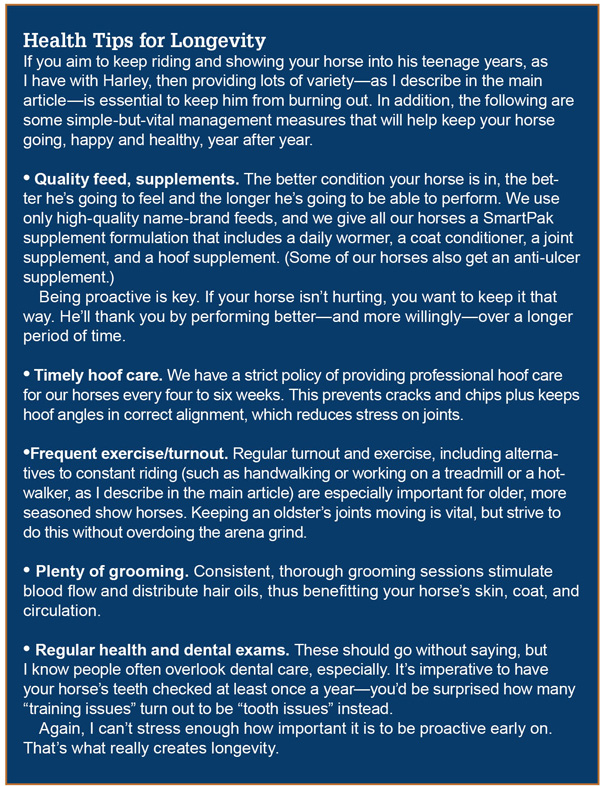
Note: As a general rule, I find that incorporating a lot of walking into schooling sessions is a great overall strategy. I call walking the “forgotten gait,” as riders tend not to work on it as much as they do the other gaits. But walking is an excellent way to teach your horse patience, because he learns he must wait until you give him further instructions.
Dictating direction: I have a general rule of thumb here that I always follow during schooling: Whatever way my horse wants to go, I make him go the opposite. This establishes and reinforces that I, the rider, am in charge.
Here’s an exercise to practice this strategy: Cut straight across the arena at a walk. It doesn’t matter where you turn in; you can cut the arena in half horizontally or vertically, as long as you’re heading toward the far wall while perpendicular to it. As you near the wall, keep your steering hand in neutral (in the center of your horse’s neck, roughly over the horn), and don’t cue your horse which way to turn. As he nears the wall and begins to make a choice of which way to go, whichever it is, make him go the opposite way. If he starts to turn left, for example, turn him right, and vice versa.
Now cut across again and repeat. Your goal, ultimately, is for your horse to remain absolutely straight while walking toward the wall until you tell him which way to turn.
After you’ve done this exercise several times at a walk and your horse is beginning to get the idea, try it at a jog, then a lope. At the lope, your horse will naturally want to turn in the direction of the lead he’s on—if he’s on the left lead, for example, he’ll want to turn left. As soon as he tips his hand, make him go the opposite way instead, but don’t change leads. Rather, have him counter-canter (that is, lope on the “wrong” lead). As you do so, be sure to allow plenty of space to make a wide turn, so you don’t get bunched up at the fence (forcing your horse to make a sharp turn on the wrong lead will unbalance him).
Anticipating the reverse: For this infraction, your horse knows when a reverse of direction is coming and wants to jump the gun. So, just as you taught him not to anticipate your “go-forward” cue, you must convince him that even if you’ve walked, jogged, and loped in one direction, it’s not his call to decide to reverse.
Do this by making him continue to walk in the original direction instead of reversing. Then jog and lope again, and see if he’s still thinking about reversing when you come back to a walk. If he is, keep walking. When he’s focused on you and waiting for your instructions, only then ask him to reverse.
Repeat the sequence as need be in the opposite direction.
THE SCHOOLING-SHOW FIX. Now for the big ammo. The most effective way to correct your horse’s cheating is to actually school him—rather than riding to win and “hiding” his misbehavior—at a schooling event or small local show. Ideally, sprinkle these genuine schooling shows every so often amongst his regular shows throughout the season.
Why? As I’ve explained, your experienced campaigner knows the difference between schooling at home and showing, and so when you school him during what he believes is a real class, it gets his attention like nothing else. For this to work, however, you must genuinely change your mindset from “winning” to “doing homework.”
For starters, find a local schooling or weekend show to attend. If that’s not an option for you, create your own mock show by soliciting several riding buddies to participate, with one person serving as the announcer. Don’t worry too much about getting dressed up in your show clothes and tack. To your horse, it’s more about the environment and the situations—waiting outside the arena gate, being around other horses, walking on the rail with other horses in the arena, and hearing the announcer.
Now, during the mock show or schooling show—even one you’ve paid entry fees for!—ride just the way you’ve been schooling at home. In other words, don’t let your horse anticipate or get away with any other misbehavior. When the announcer calls for a jog or lope, for example, hesitate before letting your horse pick up the new gait. If he tries to drag you into the gait, make him walk, even as the other horses pass you by. If you need to walk to the center of the arena and just sit there to teach your horse patience, do that. In fact, do whatever you must to be in control of your horse’s actions at all times.
Take the same strategy when the announcer calls for a reverse. Make your horse keep walking straight for a few moments; then, when it’s clearly your idea, initiate the reverse. The more time you can put between the announcer’s call and your executing the maneuver, the better your horse will learn.
During patterns and courses, if you need to stop and school at any point, or repeat a maneuver or obstacle, do so. It will blow your horse’s mind—in a good way—to realize you really are in charge…even at a show.
Keep Cheating at Bay
Once you’ve cured your horse of his cheating antics, you’ll need to keep him cured. Here are some strategies for doing that; they’ll also serve to keep a novice show horse from learning to cheat in the first place.
BE UNPREDICTABLE. Don’t follow routines your horse can learn. Keep him guessing! Use different approaches and different sequences in your schooling sessions and patterns at home. During the show season, always salt a few schooling shows into your schedule, then use them for exactly that—schooling.
MIX IT UP. Head off boredom (and a resulting desire to cheat) by giving your horse a change of scenery and assignment from time to time. Get out of the arena by going on a trail ride with friends. Maneuver an obstacle course. Work cattle. Get creative—your goal is to give your horse something interesting and different to do, so he learns life isn’t all work and no play.
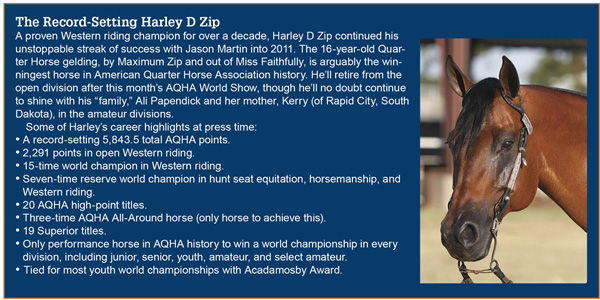
Along this same line, introduce your horse to classes other than your usual ones. If your preference is Western pleasure, try trail or Western riding once in a while. Teaching him new events provides more variety and helps to keep his brain fresh and interested.
GET OFF HIS BACK. Too much riding can wear your horse down and burn him out, encouraging the tendency to cheat. This is especially true during the show season, when a veteran campaigner can stay fit and ready to show without a lot of schooling.
Fortunately, there are alternatives to riding. I get great use from a treadmill, which provides low-impact, joint-friendly conditioning for my horses four or five times a week, for up to half an hour at a time.
A hotwalker is an alternative to a treadmill, and handwalking can provide the same benefits with the bonus of building the bond between you and your horse.
TURN HIM OUT. Give your horse at least some turnout time every day, if possible, to get his mind off the routines of schooling and showing. A few hours a day is ideal; we turn all our horses out for at least an hour a day. Allowing a horse to roam free in his natural state is excellent for his mind. It relieves stress, keeps him fresh, and makes him happier overall. And a happy horse is a willing, honest horse.
On Harley D Zip and other top horses, all-around trainer Jason Martin has been a Western riding “machine.” He’s won the championship in the senior division of that event five consecutive times at the AQHA World Show; last year he won both the senior and junior classes. In 2009 and 2010, he swept all three Western riding classes (junior, green, and senior) at the All American Quarter Horse Congress. Jason is half of the powerhouse duo at Highpoint Performance Horses in Pilot Point, Texas. He and co-head-trainer Charlie Cole have produced over 100 world champions and over 200 Congress champions in a wide range of events, plus coached many of the industry’s top youth and amateur riders. Jason’s last ride on Harley D Zip will take place at the AQHA World Show this month, when they’ll conclude Harley’s career in the open division.






